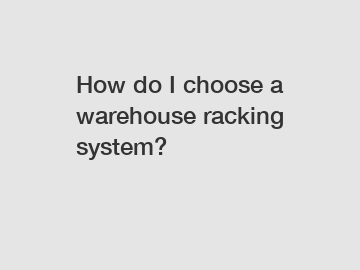How do I choose a warehouse racking system?
How do I choose a warehouse racking system?
Warehouse racking systems are essential for maximizing storage space, maintaining efficient inventory management, and ensuring smooth operations in a warehouse or distribution center. However, with a plethora of options available in the market, choosing the right racking system can be a daunting task. This article will guide you through the process of selecting a warehouse racking system that suits your specific needs and requirements.
Understanding Your Storage Needs.

Before you start considering different warehouse racking systems, it is vital to thoroughly analyze your storage needs. Consider factors such as the type and size of your inventory, its weight and dimensions, and any special requirements for storage (e.g., temperature control, hazardous materials). Having a clear understanding of your storage needs will help determine the type of racking system that you should opt for.
Types of Warehouse Racking Systems.
There are several types of warehouse racking systems available, each designed to fulfill specific storage requirements. Here are a few commonly used types:
1. Selective Racking: This is the most common type of racking system, allowing direct and unrestricted access to each pallet. It offers high flexibility and is suitable for facilities with a wide range of products.
2. Drive-In Racking: This system is ideal for high-density storage, where forklifts drive directly into the racks to retrieve or store pallets. It maximizes storage space but restricts access to select pallets.
3. Push Back Racking: Using a Last-In, First-Out (LIFO) system, push back racking allows multiple pallets to be stored in a single lane. It offers good selectivity and high storage density.
4. Pallet Flow Racking: This system operates on a First-In, First-Out (FIFO) principle, offering automatic stock rotation. It is beneficial for inventory that needs strict stock rotation.
Evaluating Other Factors.
While the type of racking system is an essential consideration, there are other factors that need to be evaluated as well. These include:
1. Cost: Consider the initial investment cost, maintenance costs, and any potential long-term savings a specific racking system may offer.
2. Safety: Ensure that the racking system adheres to all safety regulations and standards, reducing the risk of accidents in the warehouse.
3. Space Utilization: Assess how effectively the racking system can make use of the available space and maximize storage capacity.
4. Flexibility and Scalability: Determine whether the system can adapt to your future expansion plans or any changes in your inventory requirements.
Implementing and Maintaining the System.
Once you have chosen the appropriate warehouse racking system, it is important to consider its implementation and maintenance. Proper installation is crucial to ensure structural integrity and safety. Regular inspections and maintenance should be carried out to identify any potential issues and address them promptly.
Contact Us.
Choosing the right warehouse racking system is crucial for optimizing storage space, enhancing efficiency, and ensuring smooth operations. With a clear understanding of your storage needs and careful evaluation of various factors, you can make an informed decision. If you need further assistance in selecting and implementing a warehouse racking system, feel free to contact us. Our team of experts is here to help you make the right choice for your business.
Are you interested in learning more about medium duty rack, Automated Multidimensional Warehouse, Automated Multidimensional Warehouse? Contact us today to secure an expert consultation!


